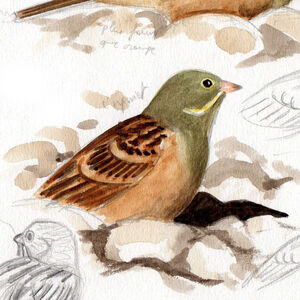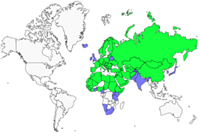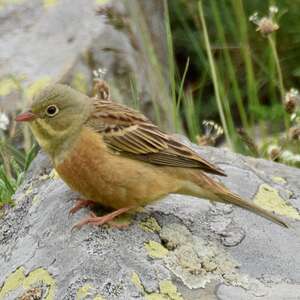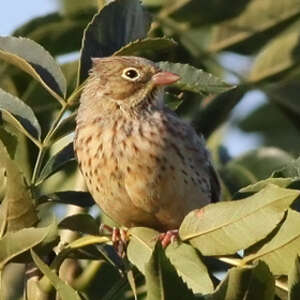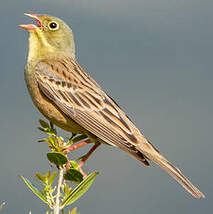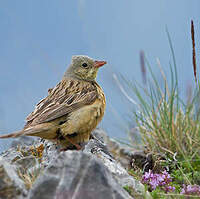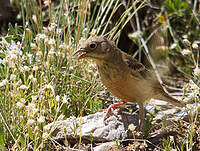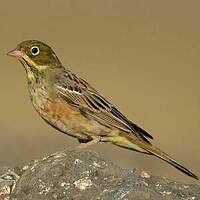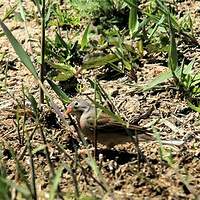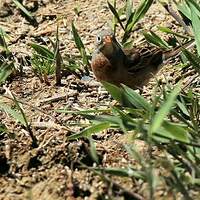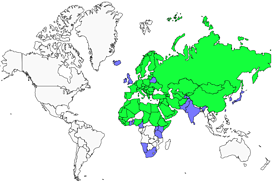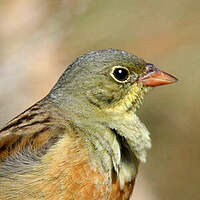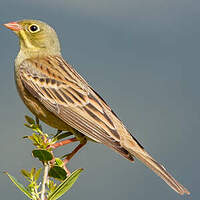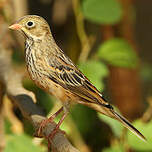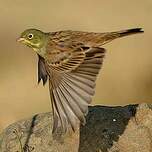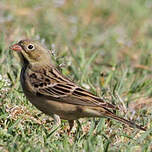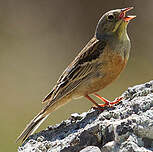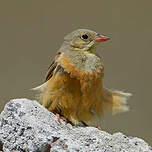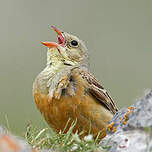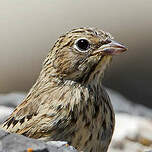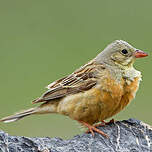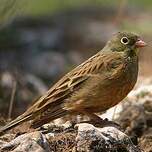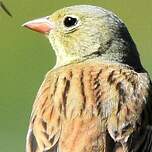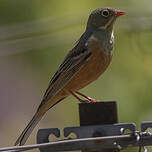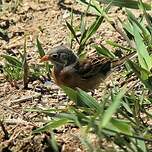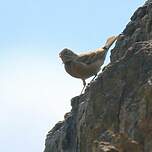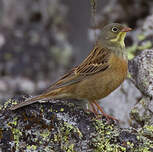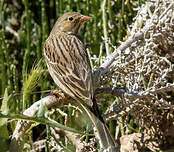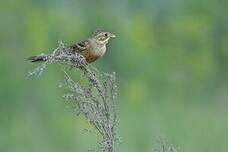Ortolan Bunting
Emberiza hortulana - Bruant ortolan
Identification
Like all buntings except for the Reed bunting, the Ortolan Bunting exhibits sexual dimorphism. The male breeding bird can be recognized by its colorful plumage. Its head has a particular shade, made up of a mixture of gray and olive green, which is quite characteristic. From the same tone come the two malar stripes and the top of the chest. The mustaches and throat are yellow. The dark eye is circled by yellow. The upper parts are a warm brownish red. The underside of the body (lower chest, belly and flanks) is clearly reddish. The tail is black, with white at the end of the three outer pairs of rectrices. The beak, well conical, and the legs are pink.
The female resembles the male but with less colorful plumage. No green tone on the head, rather brown and striped on the cap. The malar stripes are black. The eye circle, mustaches, throat and top of the chest are creamy, with the last finely striped with brown.
The juvenile resembles the female, but even more dull. The most visible character are the well-marked black streaks over the entire chest from the malar stripes. The brown head is striped on the cap and shows whitish eye circles and mustaches.
Subspecific information monotypic species
Foreign names
- Bruant ortolan,
- Escribano hortelano,
- sombria-brava,
- Ortolan,
- kerti sármány,
- Ortolaan,
- Ortolano,
- ortolansparv,
- Hortulan,
- strnádka záhradná,
- strnad zahradní,
- Hortulan,
- peltosirkku,
- Ortolanstreepkoppie,
- hortolà comú,
- Dultittlingur,
- ortolan,
- dārza stērste,
- vrtni strnad,
- Садовая овсянка,
- ズアオホオジロ,
- 圃鹀,
- 圃鵐,
Voice song and cries
The song of the Ortolan Bunting is reminiscent of that of the Yellow Bunting. It consists in the repetition of the same melancholic note followed by a lower toned note or motif. There is a great variation in the singing of the males but the typical pattern remains the same.
The usual call is a tsip or tchip even a tchiup which makes it quite a noisy bird.
Habitat
The Ortolan Bunting's habitat consists of open, cultivated or uncultivated areas with sparse woody vegetation, up to an altitude of 2500 metres locally.
In France, it is present as a nester in the southern half of the country, with its centre of gravity in the south-east. It frequents two types of habitats: cereal fields with linear rows of trees and shrubs, and grassy, open, sun-exposed slopes of the relief with a low rate of woody vegetation.
During migration, it can stop in desolate environments such as steppes and semi-deserts. In its sub-Saharan African wintering grounds, it also frequents open areas, semi-arid crops above 1000 metres, as well as wild, grassy high altitude environments.
Behaviour character trait
Dietfeeding habits
The Ortolan Bunting's diet is mixed, insectivorous and granivorous, depending on the season and circumstances. The young in the nest are mainly fed on insects, either captured on the ground like crickets or in woody areas like butterflies. During migration and in winter, seeds dominate the diet. For instance, post-nuptial migrating groups stop in harvested fields to feed.
Reproduction nesting
The Ortolan Buntings are back at their southern breeding sites by early April and the migration lasts until June for the northernmost sites.
For example, in the north of France, they arrive at the end of April-beginning of May. The territorial couples quickly settle in favorable sites, such as cultivated fields or natural grasslands. The female builds a nest of dry twigs at the ground level and lines it with very fine material. She lays 4 or 5 cream-colored eggs, marked with irregular brown or black spots, some of them typically bunting in shape. The incubation period lasts 12-13 days, and the same amount of time is dedicated to the nestlings' raising. The young birds feed on insects and grow quickly.Geographic range
The Ortolan Bunting has a wide distribution in the Western Palearctic. Its breeding range extends longitudinally from Spain to Mongolia, and latitudinally from the extreme north of Algeria and the Middle East southward, and beyond the Baltic Sea to the north. Of course, within this range, the distribution is unequal. For example, in France, it is relatively well represented in the south-east quarter of the country, but is rarely seen or absent from the Atlantic coast and the northern half.
It is a long-distance migratory bird with an entirely distinct African wintering range. Migrants reach to sub-Saharan Africa without reaching the equator. Its wintering range extends from the Atlantic coast (Senegal-Mauritania) to Somalia, with concentrations in Ethiopia.
Threats - protection
IUCN conservation status
concern
in the Wild
threatened
evaluated
The Ortolan Bunting is a species in decline (strong and constant) in France (orange list) and vulnerable in Europe. Changes in agriculture and overhunting have led to a strong regression of Ortolan Buntings in much of the Old Continent. These changes have resulted in a reduction of the diversity of habitats and increased disturbances in nesting sites. The lack of any legal status for the species for decades acted as the backdrop for the excessive hunting, mainly for culinary reasons, in France (in Les Landes). It was classified as a protected species by decree of 5 March 1999 and is included in Annex I of the Birds Directive.
It would be worth reading the article dedicated to this subject on Wikipedia Encyclopedia: https://fr.wikipedia.org/wiki/Bruant_ortolan
Sources of information
- IOC World Bird List (v14.1), Gill, F and D Donsker (Eds). 2024-04-18.
- Atlas des oiseaux de France métropolitaine. Nidification et présence hivernale. , Issa Nidal et Muller Y
- Birds of the World, The Cornell Lab of Ornithology
- Wikipédia, Wikipedia, The Free Encyclopedia
Other sources of interest
 Specification sheet created on
24/07/2023 by Jean François
Specification sheet created on
24/07/2023 by Jean FrançoisTranslation by AI Oiseaux.net
published: 16-10-2022 - Updated: 17-10-2022
© 1996-2024 Oiseaux.net
- Accipitriformes
- Aegotheliformes
- Anseriformes
- Apodiformes
- Apterygiformes
- Bucerotiformes
- Caprimulgiformes
- Cariamiformes
- Casuariiformes
- Charadriiformes
- Ciconiiformes
- Coliiformes
- Columbiformes
- Coraciiformes
- Cuculiformes
- Eurypygiformes
- Falconiformes
- Galliformes
- Gaviiformes
- Gruiformes
- Leptosomiformes
- Mesitornithiformes
- Musophagiformes
- Nyctibiiformes
- Opisthocomiformes
- Otidiformes
- Passeriformes
- Pelecaniformes
- Phaethontiformes
- Phoenicopteriformes
- Piciformes
- Podargiformes
- Podicipediformes
- Procellariiformes
- Psittaciformes
- Pterocliformes
- Rheiformes
- Sphenisciformes
- Steatornithiformes
- Strigiformes
- Struthioniformes
- Suliformes
- Tinamiformes
- Trogoniformes

